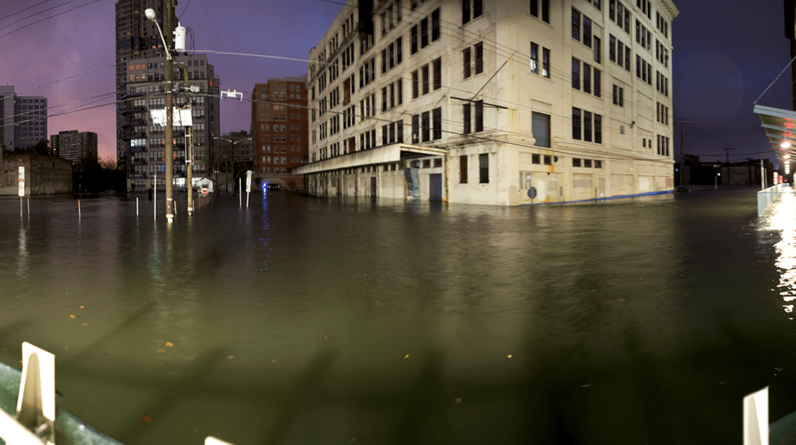
Introduction
The imperatives of climate change demand enhanced risk management in the commercial real estate (CRE) loan market: Investors and lenders must refine their strategies and conduct meticulous property-level risk assessments as part of their credit analysis. Community and regional banks are particularly susceptible to climate-related financial risk due to their CRE loan balance sheet exposure and must navigate unpriced climate risks to ensure balanced and resilient loan portfolios. To maintain portfolio health and overall stability, these institutions must exercise ongoing vigilance in their risk monitoring.
In this conversation, we — Adam W. Sandback, CFA, FRM, CPA, CMA, and Andrew Eil — assess how climate could affect CRE loans in the most at-risk areas in the United States.
Climate Risk and Community and Regional Bank CRE Loan Portfolios: What Are the Implications?
Adam W. Sandback, CFA, FRM, CPA, CMA: Property values in California, Texas, and Florida are poised to decline due to rising sea levels, heat waves, water stress, and increasingly frequent and severe natural disasters, among other unaccounted climate risks. Insurers have retreated from natural peril coverage in key geographic markets. The shift to remote work and the extensive CRE debt held by privately owned community and regional banks, combined with persistently high interest rates, heightens the systemic risks — a concern that the US Federal Reserve highlighted in its May and October 2023 reports.
Andrew Eil: Recent real estate activity suggests climate concerns aren’t deterring buyers. Florida’s CRE market is thriving, and residential values soared 80% over five years and more than 170% in a decade to March 2023. The housing markets in Texas cities and California also remain robust. Historically, there’s little precedent for climate risk affecting CRE value, yet with unprecedented climate events becoming frequent, this emerging risk may soon challenge historical norms. For example, certain highly vulnerable areas in Houston, Miami, and Norfolk, Virginia, are exhibiting local softness in market values that are starting to price in sea level rise as a risk.
Sandback: Post-2008 financial reforms have widened the risk-modeling chasm between large and small banks; the latter, more vulnerable to climate-related risks in CRE loans due to large and concentrated portfolios, struggle with less-stringent regulation, the constraints of personnel expertise, and inadequate technology for complex in-house modeling. The recent regional banking crisis underscores this issue.
Andrew, how should privately owned community and regional banks implement manageable climate-risk modeling and enhance data management and system controls to mitigate potential capital losses in a manner their resources can support?
Eil: Community and regional banks, like their larger counterparts, must integrate climate risk management because they face similar if not greater climate risk exposure due to geographic and asset class concentration in their portfolios. New standard disclosure guidelines, such as the Task Force on Climate-Related Financial Disclosures (TCFD) and International Financial Reporting Standards (IFRS) S2 Climate-Related Disclosures on governance, strategy, risk management, and metrics and targets, are a good place to begin.
This involves integrating climate change into risk appetite statements, aligning strategies and risk management policies with climate realities, and adjusting risk models to account for climate factors. Even without extensive specialized teams, banks can undertake climate risk assessments and monitor related financial risks cost effectively as climate risk data, analytics, and expertise rapidly become more affordable and accessible amid the maturing market and the proliferation of open-source data and tools.
Sandback: Rising interest rates and climate risks are converging, threatening to destabilize the commercial real estate (CRE) loan market, especially for community banks where such loans constitute half of their assets. This circumstance augurs an uptick in delinquencies and potential forced sales at reduced prices. Yet, despite $1.4 trillion in CRE loans facing maturity by 2027, evidence of climate-related discounts remains elusive. What explains the absence of visible climate discounting in the market?
Eil: One explanation is that pressing near-term concerns, such as housing affordability, low taxes, and jobs, drive consumers to the Sun Belt and climate-vulnerable locations. Another is that CRE is more regional and less neighborhood based than residential real estate, where climate factors do show up in market indicators in some areas. Given the recent ubiquity of extreme climate events, such as heat waves, droughts, floods, wildfires, and severe storms — US natural disasters with losses of $1 billion or more occurred at a record pace in 2023, despite mild hurricane and wildfire seasons — we can expect that at some point these trends will be reflected in CRE market dynamics. Indeed, a 2022 Redfin survey found that 62% of respondents consider climate and extreme weather as factors when they decide where to live.
Sandback: The combined impact of regulations and climate change could undermine property values and loan repayments, raising the risk of defaults, especially in climate-sensitive states like California, Florida, and Texas. Could these regulatory changes lead to increased defaults in these areas in the coming years, given that climate change’s effects on CRE will become more visible?
Eil: Real estate values tend to hinge on market demand and consumer outlook, but climate-related regulations may also increasingly affect them. Climate-related government policies toward the real estate sector extend far beyond required retrofits to such domains as mandatory disclosure of home flood risk exposure, adopted by both New Jersey and New York in the summer of 2023, and state-level regulation to ensure that insurance against climate-related perils is both available and affordable, such as was recently proposed in California. Local governments facing climate hazards are also prioritizing investments in climate-resilient infrastructure and enacting climate-smart building codes, which may influence perceptions of the safety and desirability of communities from now on, driving market sentiment. Climate risk disclosure and management, as well as government backstops for the real estate and insurance sectors, should help to reduce risk exposure and avoid market panic and acute repricing events.
Sandback: Given more frequent extreme weather, retrofitting buildings in climate-vulnerable states becomes essential, but financial and regulatory hurdles make it challenging. The benefits, which may far exceed the costs according to OECD research, are elusive in the face of hefty upfront expenses and various implementation barriers. Without government aid, prohibitive retrofitting costs under stringent regulations could lead to write-downs and demolitions, pushing smaller banks to heighten loan loss reserves due to depreciating collateral. Might this lead to a broad devaluation of older buildings?
Eil: As climate risks impact the real estate sector, property owners are pivoting toward resilient construction, weighing retrofit costs against potential devaluation and legal risks. This shift challenges many property owners with rising construction, maintenance, and regulatory compliance costs, as evidenced in New York City with Local Law 97. However, I suspect the performance characteristics and attractiveness of buildings more than regulation will drive CRE values in the context of climate change. Buildings with air filtration; good thermal insulation; efficient and high-performing HVAC, water, and energy systems; and resilient climate-adapted infrastructure will simply be more desirable.
Sandback: Soaring property insurance prices constitute a significant operating expense for commercial real estate in California, Florida, and Texas, especially for the large multifamily segment of the CRE loan market. Climate risk is increasingly factored into premiums as claims from natural disasters and reinsurance costs strain insurers, some to the point of insolvency. With premiums surging up to 43% in recent years and predicted to climb, affecting affordability and lending terms, how are insurers likely to respond to these risks?
Eil: Property and casualty insurers are currently retreating from certain natural perils in specific markets, such as wildfire in California and flood in Florida, a trend that will persist. State and federal regulators are now scrambling to prevent mass withdrawal by insurers, given the severe toll such a withdrawl would exact on property owners unable to secure CRE loans or sell assets. Insurers will likely adapt with more climate-sensitive risk pricing and refined underwriting techniques that identify and help mitigate climate-related risk, such as raising floor height for flood risk and managing eaves and vegetation around homes for wildfire risk.
Sandback: Despite the SEC pushing for mandatory climate risk disclosures and international bodies like IFRS calling for standardized reporting by 2024, the current reporting practices for CRE loan portfolios remain a patchwork. Given that the thousands of private community banks with significant CRE exposure often lack the capacity for such disclosures, do you expect a convergence toward a unified international standard for these smaller banks anytime soon?
Eil: The Fed recently released climate risk principles for managing climate-related financial risks, paving the way for stricter bank oversight. While the bank size threshold for regulation remains undecided, the Fed’s climate scenario analysis pilot exercise has prompted the six largest US banks and many other large and mid-size banks to scrutinize their climate risk exposure. To be candid, a framework that applies to privately held banks could take considerable time to implement and face pushback from small banks less able to comply with regulatory burdens. Nevertheless, voluntary approaches can help smaller financial institutions make meaningful headway to manage climate risk.
Sandback: You rightly underscore that community and regional banks have not adequately integrated climate risks into their CRE lending practices. Indeed, 17% of their loans are in high-flood-risk zones according to the Federal Emergency Management Agency (FEMA). The impact of climate change on CRE loan market valuations will likely become pronounced, especially in disaster-prone geographic areas, posing a significant risk to smaller banks.
Looking Ahead
Climate risks and the CRE loan market have many points of intersection that spotlight the urgent need for community and regional banks to recalibrate their risk assessment frameworks. Climate change’s current and future effects on CRE valuations, especially in natural-disaster-prone regions, underscore the risks for banks with extensive CRE exposure as well as the potential systemic risks for the CRE market and the larger financial system.
The complex challenge ahead will be to integrate climate risk into post-pandemic recovery efforts to ensure the future resilience of the CRE sector. The industry-wide elevation of risk management practices is an imperative if we are to better anticipate, prepare for, and mitigate the more pronounced market valuation impacts of climate-change-related threats, especially for banks with assets under $100 billion.
If you liked this post, don’t forget to subscribe to Enterprising Investor and the CFA Institute Research and Policy Center.
All posts are the opinion of the author. As such, they should not be construed as investment advice, nor do the opinions expressed necessarily reflect the views of CFA Institute or the author’s employer.
Image credit: ©Getty Images / Byba Sepit
Professional Learning for CFA Institute Members
CFA Institute members are empowered to self-determine and self-report professional learning (PL) credits earned, including content on Enterprising Investor. Members can record credits easily using their online PL tracker.











